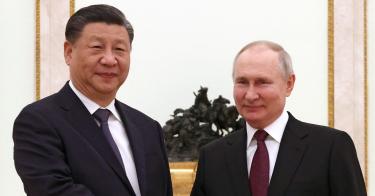Policymakers are increasingly concerned about evidence of increasing cooperation between the United States’ two greatest adversaries, Russia and China.
While recent discussion has focused on China providing Russia with lethal aid to support its aggression in Ukraine, a potentially more dangerous element to this budding relationship has just come into public view: Russian support for China’s nuclear buildup.
China is pursuing a significant nuclear expansion as part of its strategy to supplant the U.S. as the leading global power. It recently surpassed the United States in its number of long-range missile launchers, it has tested new and novel nuclear technologies, and it is now projected to possess at least as many nuclear weapons as the U.S. does by 2035, if not sooner.
Central to this nuclear buildup is China’s need for nuclear material; namely, plutonium.
Historically, China operated two nuclear power plants capable of producing weapons-grade plutonium. The two plants were shut down in 1984 and 1989, respectively, leaving China with only a limited stockpile of plutonium. But at that time, China still maintained its historic posture of “minimum deterrence,” possessing just a very limited arsenal of nuclear weapons.
With its newfound nuclear ambitions, China must remedy its limited access to plutonium. As part of the effort, China has been constructing new fast-breeder reactors called the CFR-600. While China claims these reactors serve civilian purposes, they are also equally capable of producing weapons-grade plutonium.
Compared with a typical nuclear reactor that utilizes the energy from nuclear fission to power a generator or create electricity, a fast-breeder reactor can be designed to maximize the output of plutonium from the fission reactions. For that reason, these reactors are useful for nuclear weapons programs.
That’s where Russia enters the picture.
Recent reports reveal that Russia, through its state-owned nuclear corporation, Rosatom, has been providing fuel for China’s new fast-breeder reactors. China is thought to have already purchased more than 25,000 kilograms (55,000 pounds) of fuel for a price of $384 million since shipments from Russia began arriving in September.
Nuclear collaboration between Russia and China is not entirely new. It dates back to the 1950s, when the Soviet Union provided materials and technical assistance to China’s fledging nuclear program. While tensions developed between the two states for much of the rest of the Cold War, causing nuclear aid to stop, they resumed cooperation in the 21st century.
This time, the implications of Russia’s aid to China’s plutonium reactors are quite significant. For starters, it proves that when Russian President Vladimir Putin and Chinese President Xi Jinping declared a “no limits” partnership in February 2022, they really meant it.
Perhaps worse, this development means that the more fuel Russia provides, the more plutonium China can produce. And the more plutonium China can produce, the more nuclear weapons it can build.
China is already on track to multiply the size of its stockpile over the next several years, and it’s moving faster than the U.S. had expected. In 2020, the Pentagon predicted China would double its stockpile by the end of the decade, but by the end of 2022, it had already done so. With Russian help, China might be able to accelerate this buildup even further.
Given the state of geopolitics, any advancing relationship between Russia, a country with significant nuclear experience and an abundance of nuclear material, and China, an aspiring nuclear superpower with money to spend, comes with great risk.
Meanwhile, as Russia supports China’s efforts to crank out more nuclear weapons, the United States has no similar capability to produce the cores of weapons-grade plutonium needed for new nuclear weapons, called plutonium pits.
In fact, the U.S. is the only nuclear weapons state without this capability.
The U.S. Energy Department is pursuing a project to ultimately be able to produce 80 of these plutonium pits per year, but it has been delayed, and will not be complete until after 2030. And even then, at first it will produce enough pits only to replace current aging warheads, rather than expand the inventory.
To avoid falling behind China, the U.S. needs to significantly progress on this program.
Whether the United States is prepared to admit it or not, it’s becoming increasingly clear that it will need to compete in the nuclear arena to prevent China from surging ahead and gaining nuclear advantages.
Combined with the threats posed by a recalcitrant Russia, the U.S. needs to strengthen its nuclear deterrent to ensure it retains a strategic edge against these increasingly hostile adversaries.
This piece originally appeared in The Daily Signal



